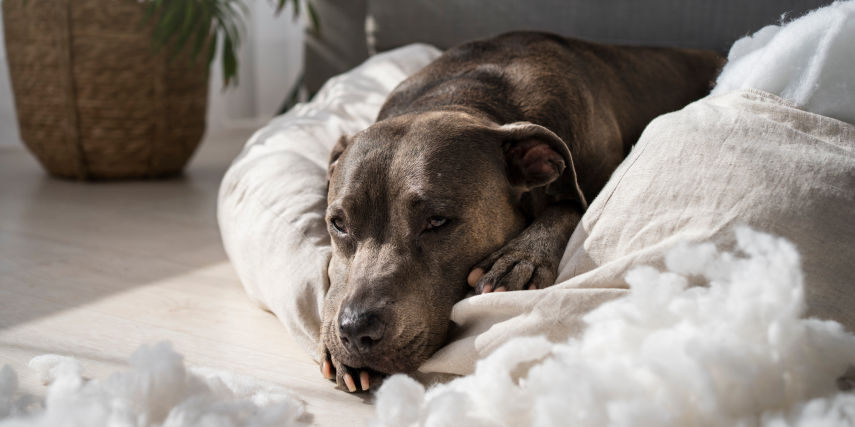Dogs have been our loyal companions for thousands of years, offering us unwavering love and affection. However, just like humans, our furry friends can experience anxiety and fear. Understanding the common causes of anxiety in dogs is crucial for ensuring their well-being and happiness.
In this blog post, we’ll delve into the world of fearful Fidos, exploring the various factors that can trigger anxiety in our canine companions and how to address them. Whether you’re a seasoned dog owner or considering bringing a new pup into your home, this information will help you provide a safe and loving environment for your four-legged friend.
Separation anxiety
One of the most prevalent causes of anxiety in dogs is separation anxiety. Dogs are social animals that form strong bonds with their human families. When left alone for extended periods, they can become anxious and distressed. This anxiety often manifests as destructive behavior, excessive barking, and even house soiling.
To address separation anxiety, consider gradual desensitization, providing stimulating toys, or seeking professional help from a dog behaviorist. Making departures and arrivals low-key can also help your dog feel more at ease when you’re not home.
Loud noises
Loud noises like thunderstorms, fireworks, or construction work can turn even the most confident dog into a trembling mess.Canine noise phobia is a common issue, and it can lead to severe anxiety. To help your dog cope with loud noises, create a safe space in your home where they can retreat.
You can also use noise-canceling headphones or calming music to drown out the loud sounds. Gradual desensitization through exposure to recorded noises at low volumes can also reduce your dog’s sensitivity to loud sounds over time. Additionally, consult your veterinarian for anxiety-reducing medications if the phobia is severe.
Social anxiety
Social anxiety is not limited to humans; dogs can experience it too. Dogs that have not been properly socialized as puppies or have had negative social interactions may develop social anxiety. Signs include fear or aggression towards other dogs or people, avoidance, or submissive behavior.
To address social anxiety, gradually expose your dog to positive social interactions, starting with controlled environments and calm, well-behaved dogs. Positive reinforcement and reward-based training can help build your dog’s confidence and reduce their anxiety in social situations.
New environments
Change can be challenging for dogs, and moving to a new environment or experiencing significant changes in their routine can trigger anxiety. Dogs are creatures of habit, and a sudden shift in their surroundings can make them feel uncertain and fearful.
To ease the transition, maintain a consistent routine, and provide familiar objects, like their bed or toys, in the new environment. Spend quality time with them to reassure them that everything is okay. Over time, they will adjust to their new surroundings and feel more secure.
Traumatic experiences
Just like humans, dogs can suffer from the lingering effects of trauma. Dogs that have experienced abuse, accidents, or other traumatic events may develop anxiety as a result. Signs can include fearfulness, aggression, or withdrawal. It’s essential to approach these dogs with patience and understanding.
Consider consulting a professional dog behaviorist to help your pet work through their trauma and regain trust in humans. Positive reinforcement and a loving environment can go a long way in helping these dogs heal.
Health issues
Underlying medical conditions can also contribute to anxiety in dogs. Chronic pain or discomfort can lead to restlessness and anxious behavior. If your dog’s anxiety appears to be tied to physical discomfort, consult your veterinarian for a thorough examination.
Treating the underlying health issue may alleviate the anxiety symptoms. Regular check-ups and a healthy lifestyle can also help prevent anxiety stemming from medical conditions.
Lack of exercise
A tired dog is often a happy dog, but many pet owners underestimate the importance of regular exercise. Dogs with excess energy and insufficient physical activity can become anxious and restless.
Make sure your dog gets plenty of exercise through daily walks, playtime, and mentally stimulating activities like puzzle toys. A tired dog is less likely to develop anxiety-related behaviors, and exercise can be an effective way to reduce stress.
Aging and cognitive decline
As dogs age, they may experience cognitive decline, which can lead to anxiety. Cognitive dysfunction syndrome (CDS) is similar to dementia in humans and can cause confusion, disorientation, and changes in behavior.
To support your aging dog, maintain a consistent routine, provide mental stimulation, and offer plenty of comfort and reassurance. Special diets and supplements designed to support cognitive function may also be beneficial, so consult your veterinarian for guidance.
Phobias
Phobias are intense and irrational fears of specific objects, animals, or situations. Common dog phobias include thunderstorms, fireworks, and specific animals. These phobias can trigger severe anxiety and panic in dogs.
Gradual desensitization and counterconditioning techniques can help desensitize your dog to the phobic trigger. Additionally, consult your veterinarian about anti-anxiety medications if your dog’s phobia significantly impacts their quality of life.
Owner’s behavior
Dogs are incredibly perceptive and can pick up on their owner’s stress and anxiety. If you’re feeling anxious or stressed, your dog may mirror those emotions. Maintaining a calm and confident demeanor around your dog can help them feel more secure and reduce their anxiety. Positive reinforcement training methods that focus on rewards and praise can also foster a strong bond and trust between you and your pet.
Conclusion
As pet owners, we want nothing but the best for our furry friends. However, anxiety can be a major barrier to a happy, healthy life for dogs. Identifying the common causes of anxiety can go a long way in supporting your pet’s emotional well-being. Whether it’s separation anxiety when you leave for work or social anxiety when meeting new dogs, there are strategies to help cope with these anxieties.
Professional resources such as dog board and training in Hillsboro can also provide effective support for your pup. By addressing anxiety head-on, you’re taking proactive steps to ensure your pet’s happiness and health.

